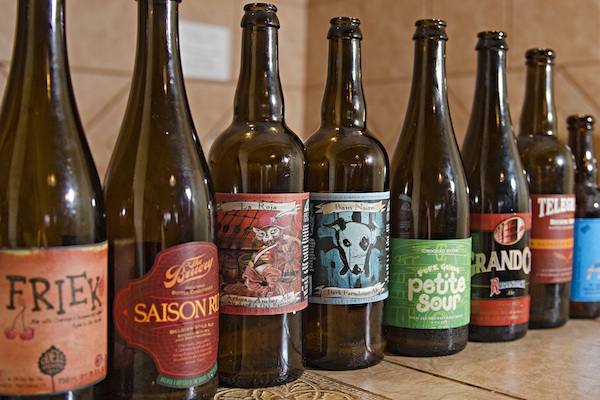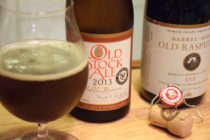Camp Beer is one of those things that always sounded like something I’d really enjoy. It’s where a group of beer aficionados get together to sample several different brands of a particular style of beer.
 I always seemed to miss the boat on getting a ticket. Either it was sold out or I already had plans. For the one held recently on Saturday, March 10, though, I hit the mother lode.
I always seemed to miss the boat on getting a ticket. Either it was sold out or I already had plans. For the one held recently on Saturday, March 10, though, I hit the mother lode.
Sours are one of my favorite styles of beer. I remember the first time Camp Beer moderator Kevin Floyd mentioned “sour beer” to me years ago at Anvil. It sounded like beer that had gone bad and was certainly nothing I wanted to try. (Actually, some sour beers smell like they have gone bad, but they haven’t.)
Justin Vann (who is now the general manager at Oxheart) is the one who got me to actually try some sour beer. He recommended Duchesse de Bourgogne. Duchess seemed as closely related to a fine wine as it did to beer, and I was hooked. From then on, I bought and tried as many sours as I could find.
The style has become so popular that Floyd declared, “Sours are the future of craft beer. At Hay Merchant [his new craft beer bar at 1100 Westheimer], we’ve sold more sour beer than Saint Arnold’s Lawnmower.”
Sour beer production allows, encourages or even adds wild strains of yeast during a secondary fermentation process. In most beer and wine making, these would be considered an infection. However, in sour beer, agents like Lactobacillus, Brettanomyces and Pediococcus are what create the distinctive tartness. Since it is not made in a sterile environment, it is the only beer style that can be considered to have terroir, much in the same way that wine does.
This iteration of Camp Beer (the 10th one held so far, per founder Cathy Rascoe) focused entirely on sours – 12 of them, in fact. Beers are served in small tulip glasses in two- or three-ounce pours, so it’s quite manageable to try them all, especially if you’re picky.
My best advice on any kind of tasting, whether it be beer, wine or spirits, is if you don’t like it or think it’s mediocre, don’t hesitate to dump it out. Save your alcohol tolerance for something better.
“Take Beano before you come,” advised Cathy. I’d never really thought about it before, but beer can contain complex sugar and yeast that will make you gassy. I obeyed the advice and am happy to say that I had no embarrassing issues after the day’s session.
Kevin and Cathy are good teachers. I appreciate when examples are thrown in not because they are good or stellar examples of the style, but because they provide needed contrast and comparison. The first one we tried, Jolly Pumpkin’s The Firefly, barely counted as a sour. It was far too mild to make much impact. Comparatively, La Roja from the same brewery was substantially tart and wine-like – everything I expect from a sour.
We learned that sours with Brettanomyces yeast that are not aged long enough can be rather unpleasant to most palates, as was the case with the Crooked Stave Pure Guava Petit Sour. The group almost universally agreed that it smelled like aged parmesan cheese, which is not exactly what you’re expecting from your beer. A few thrill seekers at my table said they actually found it rather interesting. I’ll stick with La Roja.
The last four beers on the list all found rabid favor with the group: Rodenbach Grand Cru, Telegraph Reserve Wheat Ale, Russian River Supplication and Russian River Consecration. Most of my table liked the Supplication the best. It’s aged in Pinot Noir barrels, to which sour cherries are added. Please, Russian River, if you could ever see your way to sending some of this to Texas, we would really appreciate it.
Telegraph Reserve Wheat Ale struck me much like a Hefeweizen. It was gentle, and I think beer drinkers of all types would enjoy it on a warm spring day. It turns out that it’s actually a Berliner Weisse-style beer. The slight sourness is created by a secondary fermentation in the bottle.
The Italian-American food, catered by Collina’s, was great. It not only went with beer, but also provided sufficient calories and heft to deal with the alcohol content. The pizza, meatballs and artichoke dip were all outstanding, and an ideal choice by the event planners.
The funds raised by Camp Beer go to the non-profit organization called Live It Big, which helps fund small, start-up charities. Live It Big is currently assisting Friday Harbour, which provides free, temporary housing for cancer patients undergoing treatment and their families. Live It Big also helps Stepping Stones Charter School, a small elementary school in the Alief area.
As far as upcoming events go, mark your calendars now for Houston Beer Week, which will happen this year November 10 to 17. If it’s anything like last year, it will be an exciting week chock full of beer-pairing dinners at notable restaurants, visits from guest brewers and other activities.
The highlight of Houston Beer Week is the popular Monsters of Beer festival. Last year, the festival drew more than 1,000 attendees.
The next Camp Beer will be in June and will cover ciders and tart beers, such as lambics. September will be “Stoutapalooza.” “That one requires a cab ride home,” warned one of my tablemates. “Last year, we only tried one below 10 percent ABV.”
If you’re interested in expanding your beer knowledge, Camp Beer is worth cab fare and the price of admission. For the best chance of securing tickets, follow @campbeer on Twitter for updates, or keep an eye on Camp Beer.









Follow Us